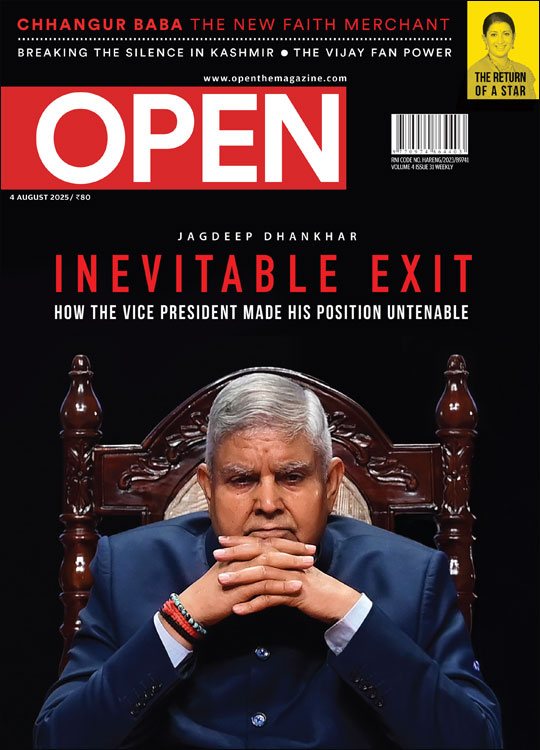Anger Management
The Government will have to balance the tide of agrarian unrest and manage its finances
 Siddharth Singh
Siddharth Singh
 Siddharth Singh
Siddharth Singh
 |
04 Jan, 2018
|
04 Jan, 2018
/wp-content/uploads/2018/01/Angermanagement1.jpg)
JUNE IS A hot month in Madhya Pradesh’s Mandsaur. Last year, the violence in the district added fuel to fire, making a live-wire national issue of the five farmers killed while protesting against a precipitous decline in crop prices. Soon enough, the political mercury rose across northern and western India. The protests spread to parts of Maharashtra and one government after another announced farm loan waivers to buy peace. In MP, the state government was quick to announce a scheme to help farmers with low market prices without undertaking an expensive loan write-off. A year later, the reverberations of these events continue to rock India’s political class. One section feels threatened while the other sees an opportunity. After four years of vanquishing economic populism, it seems the Narendra Modi Government will have to grapple with demands for state largesse as it has not seen before.
The immediate demand after the Mandsaur episode, and in many cases the response, was for government intervention. In some cases, as in Uttar Pradesh, Maharashtra and Punjab, the knee-jerk reaction was to waive off the outstanding loans of farmers. This imposed an immediate financial burden on these states and in two cases, UP and Punjab, it is particularly onerous as it comes on top of a very heavy debt burden on these states. The innovative response, however, came from Madhya Pradesh—the epicentre of the unrest—where within three months after the Mandsaur unrest, the state government launched a scheme to counter price risks faced by farmers. In case the price for a crop slumps below the Minimum Support Price (MSP), the government will directly pay the farmer the difference between the MSP and modal price of the crop. The calculation of the modal price is based on data taken from the Union Ministry of Agriculture and the rates for the crop that prevail in mandis of two neighbouring states. What roused interest in the scheme was its emphasis on non-foodgrain crops such as oilseeds and pulses, where the price risk is much higher and the farmers, on average, much less well- off as compared to those growing wheat and rice.
Within six months a number of states—Maharashtra, UP, Chhattisgarh, Rajasthan, Karnataka, Odisha and Telangana— have expressed interest in what Madhya Pradesh has done. The catch, however, lies in the groundwork that is required to make the idea work. This requires ensuring a foolproof payment system that prevents gaming of the system by farmers, commission agents in mandis and others. Registering farmers on an online database is the backbone of any such scheme and that requires their entry into a formal ecosystem of Aadhaar, banks and state- level systems. Many states are ill-equipped to handle this; some do not have the requisite systems in place, while in others a large number of farmers are yet to acquire identity documents.
But the biggest hitch in the scheme is its financing. At an immediate level, the difference between the MSP and the market price—in case the latter is lower—is to be shelled out by the state government. There are some 6.5 million farmers who grow ‘risky crops’ in MP who may finally come under the scheme’s umbrella. In case of large fluctuations in prices, the cost to the state government will rise. There are very few, if any, states that can bear such a burden. After meeting committed expenditures—salaries, pensions, interest payments, etcetera—the average state has very little wiggle room left for other expenses. If MP-type schemes are put in place, they will be more in the nature of social security and less as an economic investment. Withdrawing them will become impossible over time, unless a state is willing to tolerate social unrest and political upheaval.
Finding the money for running such ambitious plans is a question that state governments and ultimately the Union Government are yet to figure out. Madhya Pradesh, for example, has made a pitch to the Centre to share the burden of the scheme on a 50:50 basis. If the number of crops and that of participating states rises, the fiscal burden on the Centre will rise considerably. As with other social-sector schemes such as MGNREGS, it will stay in place.
These questions could not have come at a worse time for the Modi Government. In the 2017-18 Union Budget, it had promised to keep the fiscal deficit—the difference between total revenue and total expenditure—at 3.2 per cent of India’s Gross Domestic Product (GDP). This is an important promise to financial markets and foreign investors that signals a country’s ability to manage its economy. India just broke it. In the first eight months of fiscal 2017-18—the April to November period—it breached the whole year target, with the figure touching 112 per cent of what was budgeted. If this were not enough, the Government recently asked Parliament for an additional Rs 50,000 crore of borrowing. This will further add to the deficit. At this point, it looks very difficult for the fiscal year’s original target of 3.2 per cent to be met.
If anything, 2018 will be even more difficult on this score. Already there is a chorus of demands for extra spending to arrest farm distress across India. Erratic rains in the last two years coupled with a sustained downward pressure on crop prices have played havoc with farm incomes. Take two well-known examples of kharif—or monsoon crops: groundnut and cotton. Every year, the Commission for Agricultural Costs and Prices (CACP) issues detailed reports that undertake statistical analyses of yields, prices, costs and a host of other data. These are then used to advice the Government on MSPs for various crops. The report for the kharif season of 2017-18—which has the latest available data on actual costs and the returns that farmers have received in recent years—makes for alarming reading. For 2014-15, the last year for which a full analysis is available, net returns to farmers for cotton and groundnut were 6 and 10 per cent respectively. In case of coarse cereals such as jowar, bajra and ragi—largely grown in arid regions, including Rajasthan that goes to elections soon— were negative, coming in at -11, -3 and -18 per cent respectively. It should be borne in mind that these crops are not grown by rich farmers, but by those who have small, and at times, subsistence- level holdings.
One option is to carry out reforms that will reduce the number of intermediaries and procedures between the farmer and the buyer. This is what the Modi Government has begun
From here it is a simple matter of extrapolation to the political level to draw an inference about 2018. The reasoning appears to be simple: because farmers have seen little income gains over the past years, they are likely to vote with their feet against incumbent governments in the states and the Centre. This kind of ‘analysis’ has an appeal for the opposition, some sections or the ruling alliance in New Delhi who are alarmed and, of course, India’s intellectual class. From here it is a fast jump to the idea that the coming Union Budget should see a major outlay on agriculture, otherwise the Modi Government will find it hard to overcome the electoral challenge of 2019.
The evidence cited for this claim, however, is dodgy at best. In the recently concluded state Assembly election for Gujarat, the BJP witnessed a sharp reduction in its seats from 115 in 2012 to 99. The party performed particularly badly in the Saurashtra region, especially its rural parts where it was reduced to seven seats, down from its tally of 19 in 2012. On its own, this region accounted for the major dent in its electoral fortunes. If one carries out a Google search with the terms ‘Saurashtra + Groundnut + Cotton + BJP’, a large number of results are about the thesis how falling prices for cotton and groundnut are the cause of the ruling party’s troubles. This claim has been repeated innumerable times after the results poured in on 18th December. It is another matter that a careful disaggregation shows that the BJP did poorly only in rural Saurashtra and not rural Gujarat as a whole. If one excludes that region from the number of seats the BJP won or lost and considers the rest of rural Gujarat, the party’s tally remained where it was in 2012: at 36 seats. Its average winning margin even improved slightly in these seats. It need not be pointed out that farmers in rural Gujarat cultivate groundnut and cotton—just as in Saurashtra—and other oilseeds that have seen large fluctuations in prices. Clearly, the relationship between price fluctuations of crops and political outcomes is more complex than what Google searches imply.
In governance terms, electoral considerations, important as they are, should not be the sole determinant of policymaking. Farmer distress requires solutions that ought to be considered in terms of what is desirable and what is feasible. If farm activists are to be believed, a combination of ever increasing MSPs and a reduction in the cost of inputs would be an ideal solution. Much is made of the ‘Swaminathan Formula’ (MSP at a level in excess of 50 per cent of the weighted average cost of production) as a ‘solution’. If this were to be implemented, any government would face a fiscal crisis before the end of the financial year in which the proposal is adopted. It should not be forgotten that a very large part of subsidies dished out in every Union Budget for a quarter century now, if not all the way back to the 1980s, is accounted for by fertiliser and food subsidies. The latter are a misnomer as a large part of this subsidy is in effect subsidising farmers who grow wheat and rice in North India.
Apart from the fiscal constraints on what the Government can do in a single year, there is fundamental limit to intervention in the crops market. Kaushik Basu, India’s former chief economic advisor, described three conflicting objectives in this area. Either the Government can ensure an above-market price for what farmers come to sell, or it can ensure that consumers—the ones using the public distribution system being mostly poor— get as much or more food than what they would have got if the market were left completely free. Finally, the Government can ensure the above two objectives but then have no financial viability for its food market operations. It cannot ensure all three at the same time.
Basu’s description was meant for the foodgrain market. But give or take a few technical modifications, this is true for virtually all crops. The market for oilseeds, for example, has other, industrial consumers who use them as an input for finished products. If these prices are left unchecked, then the rising cost of industrial inputs will lead to inflation for a number of goods. This is one reason why idealistic solutions like the ‘Swaminathan formula’ are neither feasible nor taken seriously at the policymaking level. Under these conditions, it is not hard to understand why schemes like the one in MP are so attractive: they do not entail an open-ended commitment to keep on buying what farmers produce at ever-rising prices.
THE TROUBLE IS these are stop-gap arrangements. Ideally, there should be no need for them if farmers were not to face market rigidities for their output. Until a few years ago, crops could only be sold in government-approved and local government- controlled market yards. These yards provided a rock- bottom option where farmers could dispose of their output but at the cost of wildly fluctuating prices. With increasing demand for foodgrains, pulses, oilseeds and other commodities in India, there is no reason why they should not command much better prices. But for that to happen, a number of pieces have to fall in place. For one, the Agricultural Produce Marketing Committees Act (APMC) system—under which local markets are organised—has to be dismantled. In 2016, the Government launched the electronic National Agriculture Market (eNAM) for trading farm produce seamlessly. Two years later, the platform is yet to pick up fully and individual farmers across the country— numbering in tens of millions— have no technical wherewithal to use it effectively. There is also the question of supporting infrastructure like transporting perishable output that does not exist in large parts of the country. These are not issues that can be addressed in a single term by a government, let alone in its final year. But for all the troubles of farmers, a start has been made, however tentative it may be.
At this point, political differences emerge in policymaking. One option, which does not distort these markets, is to carry out reforms that will reduce the number of intermediaries and procedures between the farmer and the buyer. This is what the Modi Government has begun, even if it could have pushed these changes with much greater vigour. The other way is to dish out an assured price to the farmer for his output, one that does not rise with his expectations. The other side of this coin is to enact laws like the national food security law that distributes the output at rock bottom prices, but that clears the market. Both the farmer and the poor consumer are handed out doles at huge cost to the Government’s exchequer. This is the ‘soft Left option’ that found favour in the United Progressive Alliance (UPA) years.
It is a variant of that option which is now being aggressively championed by Leftist analysts and some influential sections. This is ironic. Until a couple of decades ago, it was the same kind of ‘analysis’ that blamed rising prices dished out to farmers as the reason for India’s economic atrophy. The idea was simple: increasing the prices of agricultural commodities made industrial goods expensive via what is known as the terms of trade effect. As a result, the demand for industrial goods plummeted—or more accurately, never took off—and the country’s economic fortunes declined. Much was also made of the benefits of higher prices going disproportionately to rich farmers with the poor ones getting nothing. All of it, of course, came to a naught. After the Green Revolution, many small farmers also turned viable and it took the Left by surprise when this section joined hands with those with bigger landholdings to demand better input and output prices. These sorts of ‘analyses’ ought to be taken with a large dose of salt. In the farmers unrest, the arguing class sees an alternative politics for 2019. Much like the cause of small farmers in the 1960s and 70s, this is a ruse to an ideological end. Nothing more. The Government ought to redress distress by viewing the problem dispassionately and not through a political prism.

/wp-content/uploads/2025/07/Cover-Dhankhar-New.jpg)













More Columns
Economist and House of Lords Peer Meghnad Desai Dies Lhendup G Bhutia
Tata Motors in talks to buy Italy’s Iveco in $4.5 bn deal Open
Books that expose a trusted healthcare brand Aditya Mani Jha